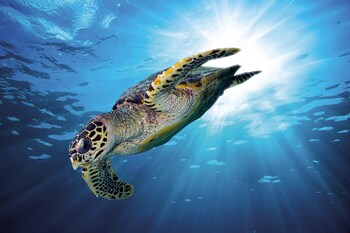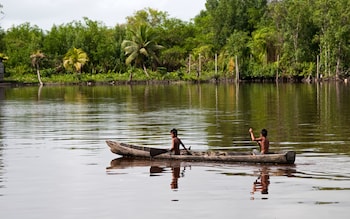It sounds like a far-fetched concept from a movie – an ecological project which sees a remote country trade some of its unspoiled “terrain” for a financial aid package that is backed by four of the planet’s most significant economies and a world-famous film star.
But the plan which is currently taking shape in the Seychelles – an ambitious environmental scheme that, if successful, will safeguard an enormous swathe of the Indian Ocean, as well as the teeming life within it – is anything but silver-screen fiction.
This archipelago nation, which sits just under 1,000 miles east of Tanzania, is better known as a holiday haven for honeymooners and celebrities who want to escape the spotlight.
But its announcement that it will create two colossal marine parks – where fish and coral will be protected – in exchange for debt relief brings it into focus as much more than an oasis of balmy weather, palm trees and luxury resorts on gorgeous beaches.
The zones are being created in exchange for the alleviation of US$22million (£16m) of national debt. In a relatively novel financial arrangement, the sum – which is owed collectively to the governments of UK, France, Belgium and Italy – has been purchased by The Nature Conservancy (TNC), a non-governmental organisation with an eco-ethos.
The identity of the Hollywood celebrity who has also lent a hand, meanwhile, is revealed in the name of the organisation – The Leonardo DiCaprio Foundation (leonardodicaprio.org) – which has donated $1million (£716,000) to the cause. The transaction will guarantee that 15 per cent of the country’s territory will be ring-fenced for marine conservation – with this percentage set to double to 30 per cent by 2021.

Leonardo DiCaprio’s foundation has donated £716,000
Credit: AFP or licensors/ANDY BUCHANAN
Currently, this adds up to a combined area of 80,300 square miles – although the Seychelles is scarcely short of space. Comprising 115 islands and islets dotted across 500,000 square miles of ocean, here is a country which breathes easily within its setting. The two new enclaves, though vast in themselves, will not make a big dent in its share of the globe.
The larger of the marine parks will be fixed at the heart of the matter, encompassing some 51,700 square miles of sea around the main island Mahé. Here, tighter restrictions on fishing will include a ban on more intensive catching methods that regularly see large numbers of dolphins, sharks and turtles snared as a by-product of the search for tuna.
The second – a “smaller” pocket of 28,600 square miles – is arguably more intriguing from a conservation perspective. It will virtually rope off the Aldabra islands – a scattering of coral islets which hides some 700 miles south-west of the Seychellois capital Victoria (on Mahé). This out-of-the-way atoll has been compared to the Galapagos islands, such is its biodiversity. As with the Ecuadorian archipelago, giant tortoises live here in significant number (the population is estimated to be about 100,000-strong) – as do green and hawksbill sea turtles, as well as dolphins and orcas.

The new marine zones will protect creatures such as sea turtles
The inaccessability of the Aldabras means the marine park around them is unlikely to become a magnet for tourists (although it is not impossible to go there). But the forward-thinking plan is not about attracting more visitors, or dragging existing ones away from their five-star sun-loungers. The Seychelles already has protected zones where holidaymakers can glimpse local wildlife with the help of a scuba mask and flippers – Sainte Anne Marine National Park, which throws its arms around eight islets three miles east of Mahé, being a case in point.
The emphasis with the new areas will be on preserving the DNA of a country where coral bleaching and drops in fish numbers have been a growing concern for much of this century. The Aldabra enclave will be strictly regulated – all fishing is prohibited there, as is any prospect of drilling for oil (despite there being a possibility that the Seychelles is sitting on rich deposits).

Guyana agreed to protect one million acres of rainforest in 2008
Of course, not everyone is impressed by the arrangement. Islanders have expressed fears that the zone around Mahé in particular will hinder their capacity to make a living. “We are worried,” fisherman Richard Bossy told The Guardian. “They want to make a lot of regulated areas where we can’t fish. Fishing is already harder. We are going to lose a lot. If there is not enough enforcement, it will never be implemented.”
His second point is also likely to be prescient – how the Seychelles will keep track of every boat in such a broad segment of water – remains to be seen. But for now, the country is basking in the glow of a project which could turn out to be a defining concept – inspiring other nations to “sell” their natural wonders to the hope of a healthier planet.
Not that the idea is entirely new. In March 2008, Guyana – the South American state which sits on the north-east shoulder of the continent, sandwiched between Venezuela and Brazil – agreed formally to preserve one million acres of its rainforest in exchange for developmental aid.
The deal saw the expansion of the Iwokrama International Centre for Rainforest Conservation and Development (iwokrama.org), which had existed in a smaller form since 1996. The area, which is open to visitors, describes itself as “unique, providing a dedicated site in which to test the concept of a truly sustainable forest”.
Source link : https://www.telegraph.co.uk/travel/destinations/africa/seychelles/articles/seychelles-protected-marine-parks-debt-relief/
Author :
Publish date : 2018-02-22 08:00:00
Copyright for syndicated content belongs to the linked Source.





